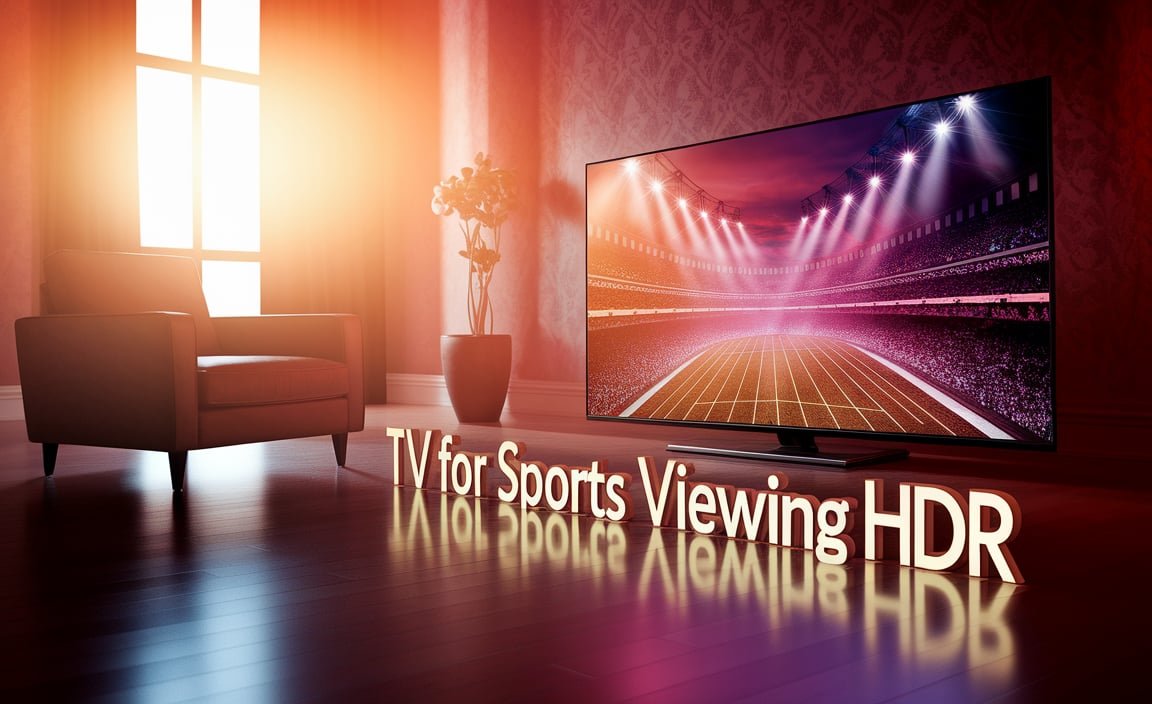Quick Summary:
Choosing the right TV size for your room is simple with our guide. Use our TV size calculator approach, considering viewing distance and room dimensions, to find the perfect fit for immersive streaming and gaming. Avoid eye strain and get cinema-like quality right at home.
Ever stood in front of a wall, dreaming of the perfect TV, only to feel overwhelmed by the sheer number of sizes? It’s a common feeling! Picking the right TV size for your space and how you watch can make a huge difference. Too small, and you might miss the magic of that big movie scene. Too big, and you could end up feeling like you’re sitting in the front row of a cinema, which isn’t always comfortable. This guide is here to help. We’ll break down how to pick the best TV size for your room, so you can enjoy your streaming, gaming, and all your favorite shows without a second thought. Let’s figure out what size is just right for you!
Why TV Size Matters for Your Room and Streaming
When you’re settling in for a movie night or jumping into a fast-paced game, the TV is the star of the show. Its size directly impacts your viewing experience. A TV that’s too small can make details hard to see, forcing you to strain your eyes, especially with high-definition content like 4K streaming. On the flip side, a TV that’s too large for the room might overwhelm your senses. Your eyes would have to dart back and forth to take in the whole picture, which can lead to discomfort and fatigue. It’s all about balance so you can truly sink into your content.
Think about it: a tiny TV in a large living room feels lost, while a massive screen crammed into a small bedroom can feel claustrophobic. Professional bodies like the Society of Motion Picture and Television Engineers (SMPTE) recommend viewing distances that ensure you can see every detail without moving your eyes excessively. This guideline is crucial for getting that cinematic feel at home. The goal is immersion – feeling like you’re part of the action. Getting the TV size right is the first step to achieving that.
Understanding Viewing Distance: The Key to the Perfect TV Size
The most critical factor when choosing a TV size is how far away you’ll be sitting from it. This “viewing distance” dictates how large a screen looks and how much of your field of vision it fills. A general rule of thumb is that the further back you sit, the larger the TV you can comfortably enjoy. If you sit too close to a large TV, you’ll see individual pixels (especially on lower resolution content) and won’t be able to take in the whole picture at once. Sit too far from a small TV, and you might miss subtle details or the full impact of the visuals.
To get a good idea of your viewing distance, measure the space between your favorite seating spot (like your couch) and where the TV will be placed. It’s best to do this when you’re actually relaxed in your usual viewing position. Don’t just estimate; grab a tape measure! Measuring accurately is far more useful than guessing, and it’s a simple step that prevents costly mistakes. Once you have this measurement, you can use it with recommended ratios to find your ideal TV size.
How To Calculate Your Ideal TV Size
Calculating the ideal TV size for your room isn’t rocket science. It primarily relies on your viewing distance. There are a few popular methods, but they all aim to achieve a similar goal: filling a comfortable portion of your field of vision without being overwhelming. This is often referred to as the “sweet spot” for viewing.
Method 1: The Simple Multiplier (THX Recommendation)
This method is very straightforward. THX, a company known for setting high standards in audio and visual quality for cinemas, has guidelines that are excellent for home theaters. For a truly immersive experience, especially for 4K content, they suggest a viewing distance of about 1 to 1.5 times the TV’s diagonal screen size. This is a great starting point for those who want that cinema-like feel.
Steps to Use the THX Multiplier:
- Measure your viewing distance in inches.
- Divide your viewing distance by the THX multiplier (1.0 to 1.5).
- The result will be the recommended diagonal screen size for your TV.
For example, if your viewing distance is 80 inches:
- 80 inches / 1.5 = approximately 53 inches (ideal for a more relaxed view)
- 80 inches / 1.0 = 80 inches (ideal for a more immersive, cinematic view)
So, for an 80-inch viewing distance, a TV between 55 and 75 inches would likely be comfortable, with larger sizes offering a more enveloping picture.
Method 2: The Aspect Ratio Method
This method takes into account the aspect ratio of modern widescreen TVs, which is typically 16:9. The recommended setup is often to have the TV screen fill about 30 to 40 degrees of your field of vision. This is a bit more technical but offers a great balance for general viewing.
Steps to Use the Aspect Ratio Method:
- Measure your viewing distance in inches.
- Multiply your viewing distance by 0.84. The result is the recommended TV size in inches for a 30-degree field of view (more cinematic).
- Multiply your viewing distance by 1.2. The result is the recommended TV size in inches for a 40-degree field of view (more relaxed).
Let’s use the same 80-inch viewing distance example:
- 80 inches 0.84 = 67.2 inches (ideal for a closer, more immersive picture)
- 80 inches 1.2 = 96 inches (ideal for a more relaxed, wider view)
This method suggests a range between 67 and 96 inches for an 80-inch viewing distance. As you can see, different methods give different results, but they all point towards larger TVs for longer distances. For 4K Ultra HD content, you can often get away with sitting closer to a larger TV without seeing pixels, so the lower end of the range might be preferred for a more impactful experience.
Method 3: The Resolution Factor (for 4K TVs)
With the advent of 4K Ultra HD resolution, which offers four times the pixels of 1080p Full HD, you can sit closer to a larger TV without noticing pixelation. This means you can potentially go for a bigger screen than traditional recommendations would suggest for your viewing distance.
For 4K TVs, the general recommendation is to have the screen fill around 40 degrees of your field of vision. This translates to a viewing distance that is roughly 1 to 1.5 times the TV’s screen diagonal. For Full HD (1080p) TVs, the recommended distance is typically 1.5 to 2.5 times the screen diagonal to avoid seeing pixels.
Simplified 4K Viewing Distance Guide:
- For a 40-inch 4K TV: Sit about 50-75 inches away.
- For a 55-inch 4K TV: Sit about 70-105 inches away.
- For a 65-inch 4K TV: Sit about 80-120 inches away.
- For a 75-inch 4K TV: Sit about 95-145 inches away.
- For a 85-inch 4K TV: Sit about 105-160 inches away.
These are general guidelines. If you prefer a more subtle picture, sit further back. If you crave that intense, immersive cinema feeling, sit closer, but always ensure the content is high resolution (like 4K streaming) to avoid pixilation.
Room Size and TV Placement Considerations
While viewing distance is paramount, the physical dimensions of your room also play a role. Simply put, a gigantic TV might not physically fit comfortably on your wall or entertainment center, even if your viewing distance technically allows for it. You need to consider:
- Wall Space: Do you have enough uninterrupted wall space to mount the TV? Remember to account for any furniture, windows, or doors.
- Furniture Arrangement: Will the TV dominate the room? Ensure there’s still comfortable seating and space to move around. The TV shouldn’t feel like it’s an obstacle.
- Entertainment Center/Stand Depth: If you’re not wall-mounting, the stand or entertainment center needs to be deep enough to support the TV securely and allow for adequate cable management.
- Eye Level: The center of the screen should ideally be at or slightly below eye level when you’re seated. This is crucial for comfortable viewing, especially during long sessions. If you have a very large TV, you might need to adjust seating or mount it lower.
For a truly comprehensive understanding of room dimensions and how they interact with your viewing setup, resources like those from home design experts can offer insights into spatial planning and furniture placement. For example, Houzz often features discussions and advice from designers on integrating technology seamlessly into living spaces.
Comparing TV Sizes: What Does It Mean in Inches?
When we talk about TV size, we’re referring to the diagonal measurement of the screen, from one corner to the opposite corner. This measurement excludes the bezel (the frame around the screen). So, a “55-inch TV” means the screen itself is 55 inches diagonally. It’s important to remember this because the actual physical dimensions, including the bezel and the TV’s stand, can make it significantly wider and taller than a simple diagonal measurement suggests.
Here’s a quick look at how common TV sizes compare:
| Diagonal Screen Size (Inches) | Approximate Width (Inches) | Approximate Height (Inches) | Common Viewing Distance (Feet) |
|---|---|---|---|
| 32 | 28 | 15.7 | 4-7 |
| 43 | 37.5 | 21 | 5.5-9 |
| 50 | 43.6 | 24.5 | 6.5-11 |
| 55 | 48 | 27 | 7-12 |
| 65 | 56.7 | 31.9 | 8-13.5 |
| 75 | 65.3 | 36.7 | 9.5-16 |
| 85 | 74 | 41.6 | 10.5-18 |
Note: Width and height are approximate for 16:9 aspect ratio screens and do not include bezels or stands. Viewing distances are general recommendations for 4K TVs and can vary based on personal preference and content type.
As you can see, even a few inches difference in diagonal size can result in a noticeable change in the overall width and height of the TV unit. Always check the manufacturer’s specifications for precise dimensions if you have limited space.
Impact of Resolution (4K vs. 1080p) on TV Size Choice
The resolution of your TV has a significant impact on how large a screen you can comfortably enjoy. Resolution refers to the number of pixels displayed on the screen. More pixels mean a sharper, more detailed image. This is where 4K (Ultra HD) truly shines compared to older 1080p (Full HD) TVs.
- 4K (Ultra HD) TVs: These have a resolution of 3840 x 2160 pixels. This extremely high pixel density means you can sit much closer to a larger 4K TV without seeing the individual pixels. The image will remain sharp and detailed. This is why recommendations for 4K TVs often suggest shorter viewing distances, allowing you to go bigger.
- 1080p (Full HD) TVs: These have a resolution of 1920 x 1080 pixels. While still great for many purposes, the lower pixel density means that if you sit too close to a larger screen (think 50 inches and up), you might start to notice a “screen door effect,” where you can see the gaps between pixels. This can make the image look less sharp.
If you’re primarily streaming 4K content from services like Netflix, Disney+, or using a 4K Blu-ray player, you have more freedom to choose a larger screen size relative to your viewing distance. If you’re mostly watching older content or streaming lower-quality sources on a large TV, you might find that a smaller screen or sitting further back is more enjoyable.
Other Factors to Consider
Beyond the core metrics, a few other things can influence your TV size decision:
- Your Budget: Larger TVs generally cost more. Set a budget before you start looking. While it’s tempting to go for the biggest screen possible, ensure it fits your financial plan.
- The Room’s Purpose: Is it a dedicated home theater, a busy living room, or a bedroom? A living room might prioritize a TV that doesn’t overwhelm the space when off, while a home theater might benefit from maximum immersion.
- Personal Preference: Ultimately, what feels right to you is key. Some people love a massive, enveloping screen, while others prefer a more subtle presence.
- Future-Proofing: While not always possible, consider trends. Larger screen sizes are becoming increasingly popular and affordable.
Choosing the Right TV Size for Streaming Services
Streaming services have made high-quality content more accessible than ever. From stunning nature documentaries in 4K HDR to action-packed blockbusters, the size of your TV directly impacts how vividly you experience these. For example, watching something like “Planet Earth III” on a 75-inch 4K TV offers a vastly different experience than on a 43-inch set. The larger screen pulls you into vast landscapes, making you feel present.
When selecting a TV size for streaming, always consider the typical resolution of the content you watch most. If you’re a 4K enthusiast, lean towards a larger screen. If you occasionally stream much older, lower-resolution content, you might want to ensure your viewing distance can accommodate it on a larger screen without looking pixelated. Ultimately, a TV that’s sized appropriately for your room and viewing distance will elevate your streaming experience, making every scene more engaging and enjoyable.
Frequently Asked Questions (FAQ)
Q1: What is the most important factor when choosing a TV size?
The most crucial factor is your viewing distance – the distance between where you’ll sit and the TV screen. This determines what size TV will offer the most comfortable and immersive experience without causing eye strain.
Q2: How do I measure my viewing distance?
Simply sit in your usual viewing spot (e.g., your couch) and measure the distance from your eyes to where the TV will be placed. Use a tape measure for accuracy. Convert this measurement to inches for most TV size calculations.
Q3: Can I buy a TV that is too big for my room?
Yes, you absolutely can. A TV that is too large for the room and viewing distance can be overwhelming, causing you to move your eyes excessively and potentially leading to discomfort. Ensure the TV size fits proportionally with your space.
Q4: Does 4K resolution allow me to sit closer to a larger TV than a 1080p TV?
Yes. 4K TVs have a much higher pixel density, meaning they are significantly sharper. This allows you to sit closer to a larger 4K screen without seeing individual pixels, providing a more immersive experience.
Q5: Is there a general rule for TV size based on room size?
While viewing distance is key, you also need to consider the physical space. For smaller rooms, smaller TVs (e.g., 32-43 inches) are often best. For medium rooms, 50-65 inches are common, and for larger rooms or dedicated home theaters, 6




